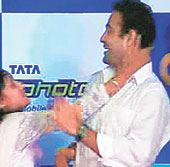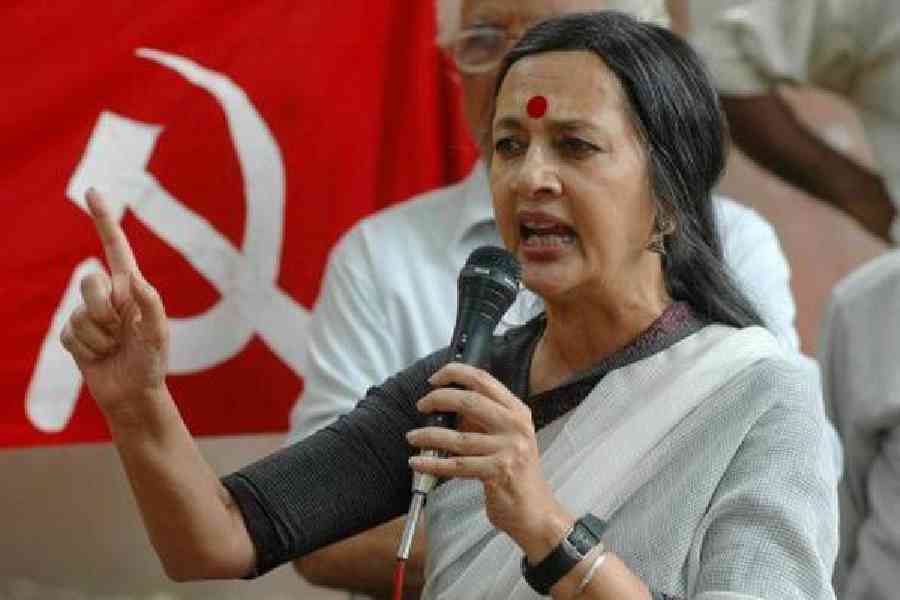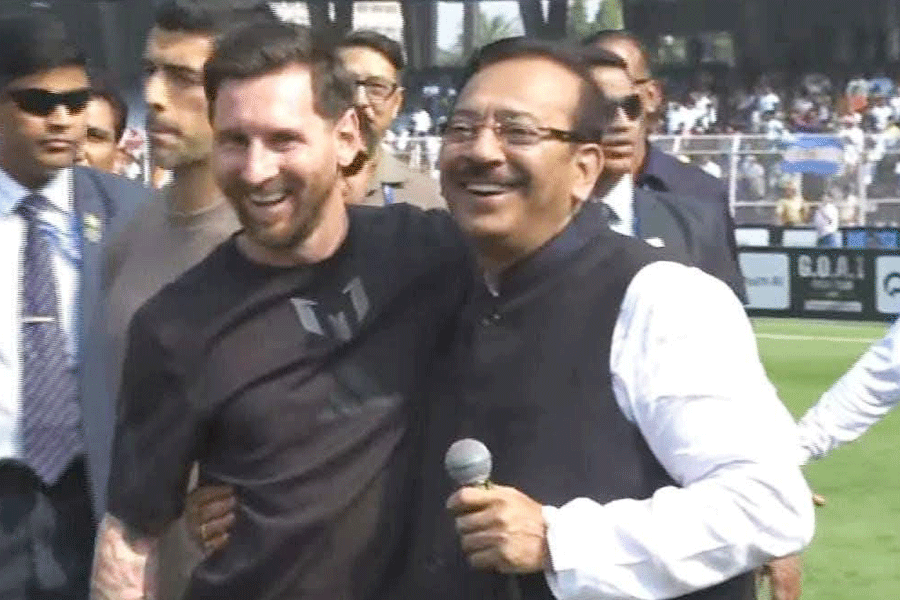 |
 |
 |
 |
 |
| Shabina Haque’s run-in with Irfan Pathan |
The painting, dating from 1960, was called The Kissing of Abbas Ali Baig, and was based on an actual incident that occurred during the third Test against Australia at Bombay’s Brabourne Stadium,” recounts Salman Rushdie’s Moraes Zogoiby (Moor), in The Moor’s Last Sigh. “When (Baig) reached 50, a pretty young woman ran out from the usually rather staid and upper-crust North Stand and kissed the batsman on the cheek.”
The kiss led commentator Vijay Merchant to exclaim: “I wonder where all these enterprising young ladies were when I was scoring my hundreds and two hundreds.” And “the gasp-provoking, scandalous kiss, a kiss between beautiful strangers” compelled Aurora, mother of Moor and an artist, to finish the painting at one go.
“‘Only in Bombay,’ people said, with that cocktail of arousal and disapproval that only a scandal can properly mix ’n’ shake. ‘What a loose town, yaar, I swear’.”
Girls — and oh boy!
Abbas Ali Baig seems to be the first of the cricketers kissed by women in a country that still doesn’t approve of kissing. Emraan Hashmi is rampant and Indians are fond of the word “lip lock”, but a kiss in public is still not quite acceptable in India. Even a peck on the cheek is considered “bold”. But only last Monday, in Calcutta, not really known to be a “loose town”, it happened again.
Shabina Haque, 24, walked up to the stage where cricketer Irfan Pathan was promoting a broadband accessory. Shabina, who works in the sales department of an insurance company, was one of the three winners at a competition. She was the second to be announced — and as everyone was waiting for the third winner to be announced, she turned towards Irfan and tried to kiss him.
Irfan refused to be kissed, but Shabina went on to be featured in a number of reports in the following days as “The-Girl-Who-Tried-To-Kiss-Irfan- Pathan”.
Two years ago, the city had witnessed “The-Girl-Who-Hugged-Mahendra-Dhoni”. Shiuli Haseena Nasrin from Khargram, Murshidabad, forced her way through the security outside Eden Gardens to hug Dhoni tight. “Aami Dhoni ke joriye dhore buke matha rekhechhilam (I hugged Dhoni and placed by head on his chest),” remembers a “mature” Shiuli now. She will not marry till Dhoni marries.
Even Indian men, apparently heterosexual, die to kiss cricketers. Australian captain Ricky Ponting was in for a rude shock in 2007 when a man tried to kiss him at an event in Bangalore to auction his bats and photographs.
“I will pay Rs 10,000 to click a picture with Ponting,” yelled Jayarama Reddy, a farmer who bid for Ponting’s autographed bat and photographs. He insisted on kissing the Aussie captain, who, sensing Reddy was drunk, tried to get away. Reddy had to be content with just a handshake. He came up on stage again after a successful bid of Rs 90,000 for Ponting’s bat and once again wished to kiss Ponting and was led away once again.
Cricket is special
Why do Indian women — and men — including a significant percentage of Calcutta women, want to kiss and hug cricketers? Why not film actors?
Are cricketers more kissable? The answer, perhaps, is a little prosaic.
“Cricketers get kissed more because they are more approachable than filmstars. The fact that they hail from middle-class roots makes the fan identify with them. Unlike filmstars, cricketers don’t have an aura,” says psychologist Mohormala Chatterjee.
Cricketers may also seem “cleaner” compared to film actors, who would appear embroiled in one affair after another with a co-actor. Or with socialites. Or with their social inferiors. Though actors, it may be remembered, regularly get their clothes torn. Hrithik Roshan is not likely to forget how he was mobbed by fans in the city during his visits in 2000. Adulation often assumes the most violent form.
Or is it that women in the city are getting bolder and bolder, almost at the rate of cricketers endorsing products?
 |
| Shiuli Haseena Nasrin with Dhoni outside Eden Gardens |
For Shiuli of Murshidabad, it was “pure love” for Dhoni that made her lunge at the Indian captain. “Dhoni got down from the bus, came in front of me and asked the guards to go. He then called me to him. I was overcome with emotion and hugged him and rested my head on his chest. I did not kiss him. When the police took me away, I was breaking into sobs,” she says.
The incident has left its mark on her life. She is often recognised in the street, on a bus or in the market. She says she is asked about Dhoni often. “But I don’t have his mobile number. I have asked many journalists for it,” she says.
Shiuli had been tracking Dhoni for five days before she could meet him.
It is not boldness, but desperation, says novelist Tilottama Majumder, that makes for such sudden — and occasionally violent — displays of affection in public. “It was more of an emotional outburst, rather than a manifestation of boldness. Boldness is always sustained and is a virtue that is proved time and again through various actions,” says Majumder of the Shabina incident.
Celeb worshippers
Abroad perhaps only groupies show this kind of obsessive attachment. A groupie is a fan, usually female, who attaches herself to a music group or a celebrity, for sexual and/or emotional intimacy, for a period of time. Rock singers and groups attracted groupies famously — well known among them were Nancy Spungen and The GTOs (Girls Together Outrageously).
Apple Scruffs, a song from George Harrison’s album All Things Must Pass, refers to a group of teenage girls who waited outside the Beatles’ Apple Corps offices, Abbey Road Studios, and Paul McCartney’s home, and even slept outside in bad weather just to get a glimpse of one of the Beatles. The Beatles’ song She Came in Through the Bathroom Window is about the day a few “Scruffs” climbed into Paul McCartney’s house through a bathroom window and stole his pants from his closet which they took turns to wear. They also took a framed photograph, which they later returned at Paul’s request. Psychologists abroad call it the “Celebrity Worship Syndrome”, an obsessive-addictive disorder in which a person becomes overly involved with the details of a celebrity’s personal life. Many obsess over film, television, sport and pop stars, while others have unlikely icons such as politicians or authors.
Consequences
In the country and the city, all a woman can give to her idol without getting into deep trouble is a kiss or a hug.
Which too may be quite problematic. The kiss may be looked down upon by someone who has just hugged.
Shiuli is disapproving of Shabina’s attempt to “kiss” Pathan. “She shouldn’t have tried to kiss Irfan after he refused her,” says Shiuli, a third-year student at Behrampore College.
Her encounter with Dhoni was “different”, she says, because she didn’t “kiss” him.
Shiuli denies that she has faced any unsavoury behaviour, but she sounds somewhat uncomfortable about the closeness of her encounter with him. “I feel that instead of hugging him I should have held his hand or given him a ‘flying kiss’,” she says. “But I was standing in front of Dhoni after having dreamt of it for long. I couldn’t control myself.”
Though she has to control her feelings about reports about Dhoni’s “girlfriend”. “I feel violent. But I control my emotions.”
The kiss can have consequences. Even in fiction.
 |
| Abbas Ali Baig |
In Rushdie’s novel, Aurora painting The Kissing of Abbas Ali Baig becomes touched with the ideals of multiplicity and secularism in a Bombay that is yet to become Mumbai. But the consequences of the painting are not very happy for either the painter or its subjects. The kiss between a “Muslim” player and a young “Hindu” girl is not welcome in its depiction — Aurora is suddenly described as a “Christian” artist.
Later the painting is politicised. Hindu fundamentalist leader Raman “Mainduck” Fielding, founder of Mumbai’s Axis, says of Baig that he had the nerve to kiss “our patriotic Hindu girls”. In fiction or outside it, the kisser gets an attention that does not make her feel comfortable.
Even celebs don’t escape the wrath. In 1980, Padmini Kolhapure, a young aspiring Bollywood heroine then, side-stepped security and planted a kiss on Prince Charles’s cheek. The nation went hysterical. A few years later in 1993 a much older Shabana Azmi’s peck on Nelson Mandela’s cheek, which perhaps had more to do with her activist’s zeal than anything else, kicked off another hysteria, angering the Muslim community.
Dos and don’ts
Shabina, however, thinks that Irfan Pathan behaved more oddly than she did. He pushed her away, first gently with one hand, then more firmly with both. She does not say that she worships Pathan either. “I would have just kissed or hugged him as a friend. Nothing more,” says Shabina.
But then she would show equal fervour towards any celeb. “I would have done the same with any other celeb. Koi agar koi celeb ko dekhe to touch karna ya hug karna normal hai (It is all right to touch and hug a celeb),” she says.
She says that she is somewhat like a celebrity after the run-in with Pathan. People have told her that she has done a “courageous” thing. Everyone is calling her up. At her office, colleagues are being photographed with her and sticking the pictures on Orkut.
“Only those jealous of me are asking ‘Kyun aise kiya?’” She is enjoying the attention.
But she would like to make a few things clear. One, she didn’t lunge at him as was mentioned in some reports. Two, she would never, ever kiss Pathan on his lips.
And her boyfriend was angry because he was not mentioned in the reports. He would like the world to know that there was nothing morally wrong with his girlfriend’s attempted kiss.











